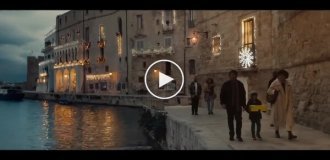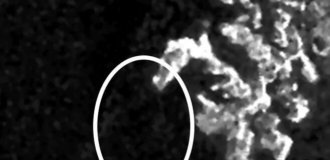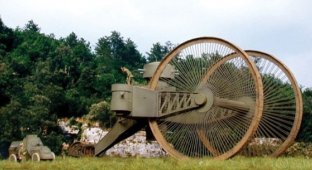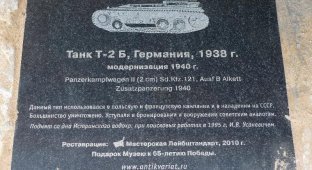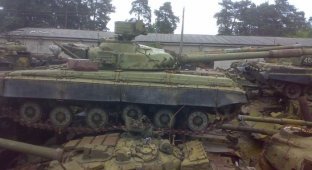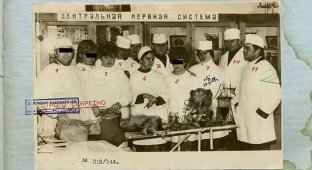In 1951, the Union began work on creating mounted individual watercraft for tanks. The first samples for the T-54 tank were manufactured in 1952 and then tested on the Oka River. In 1953-54, preliminary sea trials were carried out. In 1957, the craft was put into service under the designation PST-54. According to the state, there should have been up to 187 units of such means in a motorized rifle division (according to the number of tanks). Production was carried out at the Navashinsky plant No. 342, and the additional equipment of the tanks was carried out at the Kharkov plant No. 75. The T-54, adapted for the use of watercraft, received the factory designation “object 485”.
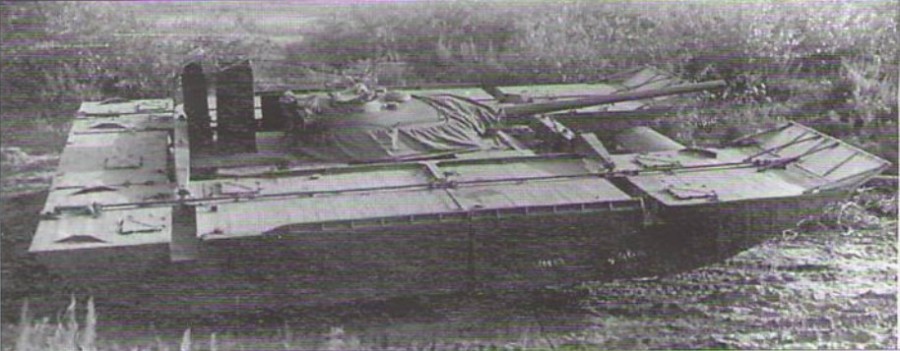
T-54 with a set of PST-54 watercraft. 1952
In parallel, work was carried out to create watercraft for the T-55 and ZSU-57-2 tanks (they were designated, respectively, PST-55 (project K-4183) and PST. The modified ZSU-57-2 received the index “object 510”). In 1959, plants No. 342 and No. 174 carried out work to unify watercraft. In 1960, an improved watercraft under the designation PST-U (universal) was adopted by the SA.

T-54B with PST-U watercraft
The PST-U set consisted of five steel pontoons (two main side, two folding side and aft) filled with foam. The total weight of the craft was 10 tons. The buoyancy reserve with the T-54 tank was equal to 40%. Movement afloat was carried out using two propellers with power take-off from the driving wheels of the tank. The maximum speed of a tank with a watercraft on land was 19 km/h, and afloat - 12 km/h. Towing was allowed at speeds up to 15 km/h. The watercraft had fuel tanks with a capacity of 500 liters, which provided a range of 60-80 km (fuel from the tank tanks was not consumed).

T-54B with PST-U watercraft

T-55 with watercraft during testing
Overcoming water obstacles could be carried out with waves up to 5 points. Firing from a cannon - up to 1.5 points (for ZSU-57-2 - shooting at anti-aircraft targets with waves up to 2 points). Along with the tank, it was allowed to transport troops with personal weapons of up to 25 people (for ZSU-57-2 - up to 40 people); when the troops were on the deck of the craft, firing from a cannon was prohibited. The crew took 35 minutes to attach the craft to the tank, and the release was carried out instantly, without the crew leaving the vehicle. The PST-54 watercraft was transported on four ZIS-151 type vehicles

ZSU-57-2 with PST

Tests of ZSU-57-2 with PST on the Black Sea
In 1962, the PS-1 lightweight watercraft for the T-55 tank and the BTS-2 tank tractor were tested. The mass of PS-1 was 5.5 tons (pontoons are not steel, but made of aluminum alloy), the maximum speeds of the BTS-2 tractor with a watercraft: afloat forward - 13.7 km/h, backward - 8 km/h, afloat behind a tug - up to 19 km/h, on a dirt road - 25 km/h. The power reserve, taking into account additional fuel tanks, is up to 100 km. The watercraft was transported by two ZIL-157V vehicles.

BTS-2 tractor with PS-1 watercraft
Tests have shown that the PS-1 is superior in seaworthiness to the PST-54 and PST-U. In 1965, after modification, the craft under the designation PST-63 was put into service.
Subsequently, work was carried out to improve the watercraft, which led to the appearance of modifications PST-63M and PST-64 for the T-55 and T-62 tanks.

T-55 with PST-63
A cut from the series "Armor of Russia"
Heavy tanks were also not ignored. In 1955-57. TsKB-50 was developing a similar Project 755 watercraft for the T-10 tank. At the Krasnoye Sormovo plant in Gorky, three experimental Project 755 watercraft were built for testing.

T-10 with project 755 watercraft
Since the late 1950s, in parallel with displacement landing craft, the design of high-speed hydrofoil landing craft began. Since 1958, the Central Design Bureau for SPK and SKV of the Navashinsky shipbuilding plant has been developing a high-speed tank-landing craft of Project 80 with retractable hydrofoils. The watercraft set consisted of two boats with a displacement of 12 tons, which made it possible to transport a medium tank at a speed of up to 30 knots. for a range of up to 400 km with waves up to 5 points. Each pontoon boat had its own 1000-horsepower engine. The transported tank could independently enter the water and go ashore and fire, which could enhance the power of the landing force. An experimental complex of watercraft was created in 1961.


In 1967-68. Two prototypes were tested and serial production of the watercraft began. Two battalions were equipped with them - one each in the Baltic and the Black Sea.

T-55 with hydrofoil

Project 80 watercraft.
In 1971, Project 80 was closed. Why - none of our current consultants could answer. True, it’s not difficult to guess. In order for a tank to carry two 15-ton boats, it must be equipped with fastening units, the mass of which, according to conservative estimates, will be 2–5% of the mass of the tank itself. This is about a ton of dead metal, which the tank may only need once, but which it must carry with it always.
The tank's suspension is not designed for such loads: it is believed that even the weight of the KMT-6 blade trawl (800 kg) leads to rapid destruction of the front roller bearings. If the chassis is designed for an additional weight of 30–40 tons, then, freed from the ships after leaving the water, the tank will have too stiff a suspension, which will lead to a complete loss of its shock-absorbing properties. The tank will not be able to move normally on land and fire.
And yet the main problems of “Project 80” are tactical. A landing operation involves the simultaneous participation of several hundred or at least dozens of ships moving according to a strict schedule. Tanks, infantry, artillery, sappers, and support equipment must land ashore in a certain order. By the time the Project 80 battalion approaches the shore, it must be covered by naval artillery fire. For conventional landing craft, this issue is resolved simply - some of the artillery is located on the landing craft themselves, and some is on artillery support ships that move along with the landing craft. But what about “Project 80”? Artillery support vessels will not be able to accompany such a battalion, since their speed is two to three times lower. This means that they must move to the landing site earlier. And in this case, the very meaning of high-speed landing of tanks is lost: the enemy, having seen the artillery support ships, will be ready to meet the “winged tanks” with fire.
What are tanks without infantry, without artillery, without sappers, without ammunition? The ammunition will be enough for 30 minutes of battle, unless the tanks are burned by enemy grenade launchers before that. Perhaps a hydrofoil tank could unexpectedly approach the combat zone as reinforcements, landing a little further away on an unguarded part of the coast. But, you see, this is a very modest role for such an ambitious project.



